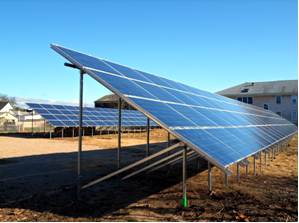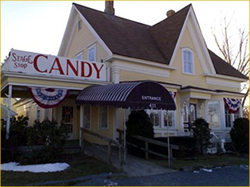
Solar Sweets: Stage Stop Candy Goes Solar
by Sheryll Hirschberger Reichwein
Like many small business owners, Ray and Donna Hebert were distressed when they saw how the recession was affecting their finances. Explains Ray, “Our 401k was going down the toilet. We had to decide on a better place to put our money.”
Gold? Silver? Stocks? Bonds?
None of the above. Worried that traditional options would not give them a return they could depend on, Ray and Donna made a surprising choice - solar energy.
“We chose solar energy because it’s a smart investment,” says Ray. “Investments always come with risk, but this is a good risk. When I realized I could get a 13.8% return, I couldn’t afford not to do this.”
Ray Hebert is a third generation chocolatier. His grandfather, Frederick E. Hebert, started his own chocolate business in Fitchburg, Massachusetts more than 75 years ago and was a pioneer of “white” chocolate, created as a caffeine free alternative for chocolate lovers who could not enjoy cocoa.
Today, while Ray still uses many of the formulas his grandfather perfected, he is also continually innovating. His “Haute-Chocolate” creations include fruit and caramel trifles, rich ganache truffles, and his unique “Around the World” chocolates.
In 1982, Ray and Donna opened Stage Stop Candy at 411 Main Street, Dennisport in what was once the 19th century home of Captain Jonathan P. Edwards. The property consists of 2800 square feet of production facility, 2100 square feet of storage, and about 900 square feet of showroom. All that space requires lots of electricity.
Explains Ray, “Our electric bill is over $14,000 a year. The tanks we use to heat the chocolate require lots of energy, 1 kilowatt of electricity each hour. And, we have nine of them.”
During August, when Ray’s electric bill exceeds $1,400, these large double boiler-style tanks both use lots of energy and generate lots of heat. To counteract the heat, Ray wraps the boilers in insulated sheets and quilts, and cranks up the air conditioning.
Using so much expensive electricity for heating and cooling at the same time bothered Ray, causing him to often ask, “When are they going to make AC that runs on the sun?”
Next August, he’ll have the satisfaction of knowing he has truly harnessed the power of the sun to run his AC.
The property sits on 1.66 acres, one-third of which is now devoted to a ground-mounted 32.8 kw solar installation with 156 solar panels. Sitting on metal frames and angled to maximize contact with sunlight, the system is anticipated to generate 36,481 kw hours per year. With a current commercial rate value of $.27 per watt, that’s nearly $10,000 in annual electrical bills that Ray will not be paying to his utility company.
With electricity rates steadily rising, the amount will continue to grow each year. In approximately five years, when the system’s initial investment has been returned, the money that would have gone to the electric company will be deposited in Ray and Donna’s 401K.
With a system life expectancy of 25 to 40 years and minimal maintenance expenses, they can bank on hundreds of thousand of dollars of reliable income. Also, 33,197 pounds of carbon dioxide that Stage Stop Candy’s utility-generated electricity would have created will not be added to the atmosphere.
While Ray had thought about solar energy for a number of years, the $255,840 price tag for a system the right size was daunting. That is, until he learned the 30% tax incentive the Federal Government was offering could now be taken as a grant.
In addition, a Massachusetts state program known as “Commonwealth Solar” offered a generous rebate. With these two incentives, he learned more than half of the cost of his installation would be returned to him. “This was a green decision. Sure, there are lots of good environmental reasons for solar. But for me it was about a different kind of green - the money kind.”
Stage Stop Candy received one of the last Commonwealth Solar grants, as the program ran out of its originally allocated money and closed in October.
However, in January 2010 Commonwealth Solar II will be launched, with rebates for homeowners and small commercial properties. In addition, the Department of Energy Resources will begin a program that provides solar installation owners with an annual financial return, known as “Solar Renewable Energy Credits,” for the kilowatt hours they generate.
Ray was also persuaded by a new Massachusetts law which mandates utilities to pay retail price to solar installation owners for electricity they generate and do not use. Known as “Net Metering,” solar installation owners can actually see their electrical meters spin backwards as their excess electricity is fed into the grid to be used by others.

The solar installation owner becomes, in essence, the owner of a small electrical power plant. Utility bills reflect credits for the electricity fed into the grid, which can be applied towards electricity used when the sun is not accessible. When the excess electricity exceeds the amount used, the solar installation owner can actually receive a check from their utility company.
As Ray explains; “If everyone installed solar, the utilities wouldn’t have to build more power plants. Today, right now, we can level the playing field. Invest in ourselves. In the future, I think we’re going to wonder what took us so long to catch on.”
Navigating through all of the incentives and submitting the necessary paperwork to state agencies and the utility company can be overwhelming. In addition to designing, permitting, and installing an effective solar system, trained solar energy professionals also make sure you receive all of the incentives you are entitled to. Ray chose Matthew Arner of SolarFlair Energy, Inc. of Westborough to manage his project.
“When I started talking about solar, my son suggested Matt, who was one of his fraternity brothers. Matt’s been great. Any time I received another piece of paperwork, I just passed it on to him. He’s handled everything,” Ray says. “Solar is a big investment and you’re taking a risk, so you really need to trust your installer.”
As of the writing of this article, Ray’s solar electrical system is installed, approved by his utility company, NStar, and ready to begin generating energy to help make his chocolate and light his neighbors’ homes. However, the Net Metering law allows NStar 45 days to activate his system and they appear to be in no hurry to do so.
“I feel like a kid waiting for Christmas. Santa is on the roof. Waiting. For NStar. I hope they let us start soon.”
Return to Environment page
Sheryll Hirschberger Reichwein is a longtime contributor to Cape Women Magazine and CapeWomenOnline.com.
She and her husband, Douglas, a licensed building contractor and solar energy expert, recently founded Solar Energy Sense a company devoted to “Repowering the World One Rooftop at a Time.”
Learn more about solar energy services.
Solar Electrical Systems FAQ’s
Q: How do I know if I have enough sunlight for a solar system?
A: There is often a misperception that strong sunlight is need for a solar electrical system to work. In fact, there is enough sunlight to make solar energy systems useful and effective nearly everywhere in the United States, including homes in New England.
Q: Do I need to have a south-facing roof to install a solar electrical system?
A: A south-facing roof area is optimal, but solar electric panels can be mounted on west- or east- facing roofs and still produce better than 90 percent of the power of a true south roof mounting.
Q: What other options do I have if the system cannot be mounted on my roof?
A: If a roof-mounted system proves impractical, a ground-mount, trellis or pergola application may be an option.
Q: What is net metering?
A: Net metering measures the difference between the electricity you buy from your utility and the electricity you produce with your solar energy system. Under net metering, any excess electricity produced by your solar energy system is delivered back into the utility grid, effectively spinning your meter backwards. Your meter spins forward when your solar energy system is not producing all of the electricity you are currently using. Your electric meter keeps track of this net difference as you generate electricity and take electricity from the utility grid. Net metering is now required by law in Massachusetts.
Q: Will a system produce enough energy to cover all my electricity needs?
A: While we are happy to provide you with a system that supplies 100 percent of your energy needs it is important to understand that a solar electric system does not need to provide all of the electricity you need to be of great value. A small system that displaces an average of one-quarter to one-half of your average demand will still substantially reduce your electric bill.
Q: What is the lifespan of the solar modules?
A: Most experts believe solar electric modules have a lifespan of at least 25 to 30 years. However, the truth is that we don't really know for sure since most modern solar panels have not been in existence that long. Many experts believe the actual number could be much higher, possibly as much as 50 years. What is very clear is that solar modules are extremely durable, have no moving parts, and lose very little of their energy generating capacity over time. This is one of the reasons that they make sense as a long-term investment.

